#Abbot represents
Quote
Today's Christians: dropping 2 buss loads of people off in an unfamiliar place in 18 degree temperature without any support.
12/24/2022
#Christianity#Christian#Jesus Christ#christians#lack of empathy#immoral#don't be like Christians#Bible#evangelicals#GOP#republican#shameful#Abbot represents#christians support#evil
8 notes
·
View notes
Text
Today is All Saints Day, and I'm observing it in a somewhat unconventional manner: cyberbullying the Anglican Church in North America
The ACNA, if you're not familiar, is a group that splintered off from the Episcopal Church in 2009. The reason for the schism was that they believed TEC had "gone astray" by ordaining women priests and affirming LGBTQ people, so a bunch of conservative Episcopalians and clergy split off into their own group: the ACNA. They claim to be "continuing" Anglicans, representing the "real" Anglican tradition in the US and Canada.
The reason I'm cyberbullying them on All Saints Day is because they are conspicuously missing a lovely, pious, respectable, and orthodox Anglican saint: Saint Aelred of Rievaulx (1110-1167 CE)
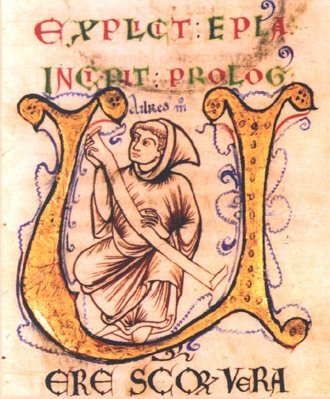
St. Aelred was a monk, abbot, historian, and spiritual writer from Northumbria. During his lifetime, the abbey boasted hundreds of monks and lay brothers, because Aelred was known for his friendly and gentle demeanor, wise leadership, and healthy community. He had the ear of kings and bishops all over northern Europe. He preached charity, humility, chastity, and all kinds of other Christian virtues. In short, he was the very model of a respectable medieval churchman.
He was also Very Much In Love With Men, and he wrote a treatise called "Spiritual Friendship," which might be nicknamed "How To Be In Love With Men In A God-Honoring Way." I've read it. It's wonderful and timeless and also very, very gay. He was in love with men. In a gay way.
Fast forward to the year 1980. Up until this point, St. Aelred had been a somewhat obscure local English saint. And then a groundbreaking new book was published which challenged all conventional narratives surrounding the Church and queer people in the Middle Ages: Christianity, Social Tolerance and Homosexuality by John Boswell. Boswell wrote at some length about Aelred and his love for men, drawing on his other work besides "Spiritual Friendship" and situating him into what was actually something of a "golden age" of gay culture in western Europe. Yes, really.
Fast forward again to the year 1985. At the Episcopal Church's general convention that year, members of Integrity USA (the original LGBTQ advocacy org in TEC) campaigned to have St. Aelred added to the calendar of saints. The House of Bishops agreed, and they added him to the church calendar with full knowledge that Aelred was gay.
Aelred was also physically disabled, and he wrote about his Spiritual Friend becoming "my hand, my eye, the staff of my old age": in other words, his Spiritual Friend was his caretaker as his health declined near the end of his life (which was still quite short even for a medieval person). He also describes the pain of his Spiritual Friend's early death in a way that remains tender 800 years later. I will leave you to imagine why that might be spiritually relevant to a bunch of nice church gays in 1985.
Fast forward again to 2009. The conservative wing of the Church has had enough of TEC's bleeding-heart liberal reforms, so they secede from the union leave and establish their own church without any icky queers or women priests. St. Aelred had been an official Episcopal saint for 25 years at that point, and the newly-formed ACNA had to consciously, deliberately choose to remove him from their calendar of saints.
Fast forward again to earlier this summer. I start doing research into queer Christian history and queer saints. I realize that Aelred is conspicuously missing from the ACNA's calendar, so I look into the background and decide to get obnoxious about it on Instagram. Because this is VERY embarrassing for a church that claims to be the "real" Anglican Church in North America.
A selection of memes for your enjoyment:




268 notes
·
View notes
Text
Regarding this post.
I think I did come to a conclusion regarding this whole bishop!Aziraphale mess.
There could be a thousand reasons, why he was a bishop. Could be curiosity in human religion, could be his roleplay hobby showing, could be for a mission and so on. I don't think he was lying here. As far as we know, Aziraphale takes his jobs very seriously. He wouldn't do anything half-heartedly (for example: learning french the hard way or insisting to take a driving test, although he doesn't need one).
My personal hc is, that it was a disguise for a mission.
But let me explain.
So Neil did mention a scrapped “15th century papal” minisode for S2. This could refer to a lot of things of course. For my hc I'm choosing the following event.
At the beginning of the 15th century there was a split within the catholic church, also known as the Papal Schism. Long story short, there where three rival popes (Pope Gregory XII in Rome, Pope Benedict XIII in Avignon and Pope John XXIII in Pisa), who claimed to be the rightful head of the catholic church. The increasing secularization of the church in general was a problem too.
So to unite the catholic church again, a council was held (also known as the Council of Constance) to decide, which pope was the rightful one. The whole council was a single chaotic mess. The only pope, who showed up, secrectly fled again and was later put in jail. The other two didn't even appear and also disqualified themselves so to speak. Finally in 1417, three years after the council started, the joint Pope Martin V. was elected, which ended the schism.
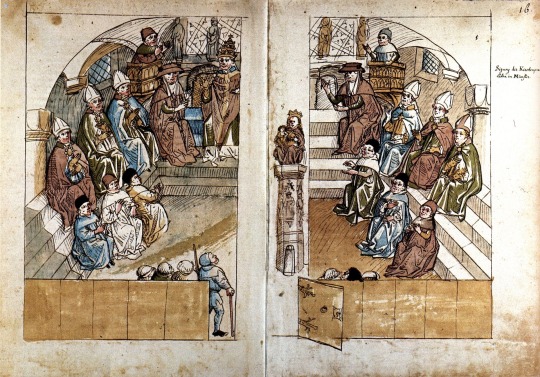
Just some bishops and cardinals chilling together, debating with Pope John XXIII.
Anyway my point is, the council was attended by a large number of cardinals, abbots, bishops and archbishops from different nations, such as England, Germany, France, Italy, Poland, Hungary, Scandinavia, etc. One can imagine the council as some kind of medieval Wacken, the biggest party at this time with emperors, nobles, peasents, handyman, merchants and generally thousands of people from all around the world, who gathered in the small city of Constance.
It would be easy for a certain angel to dive in the mass and disguise as a bishop. Why? Maybe he got a strong word from Up ("Hey Aziraphale, what's going on with Gods representative on earth? Humans make a mockery of Her ineffability!" "Um, it gotten a bit out of hand, yeah." "Sort this out immediately!" "As you wish...")
So Aziraphale thought of a plan and attended the council as a bishop to make sure that this time a righteous person would be chosen as Pope. After the election though he was quick to get rid of his regalia. Human religion didn't fit what he envisioned and he decided that angels shouldn't meddle with it.
151 notes
·
View notes
Text
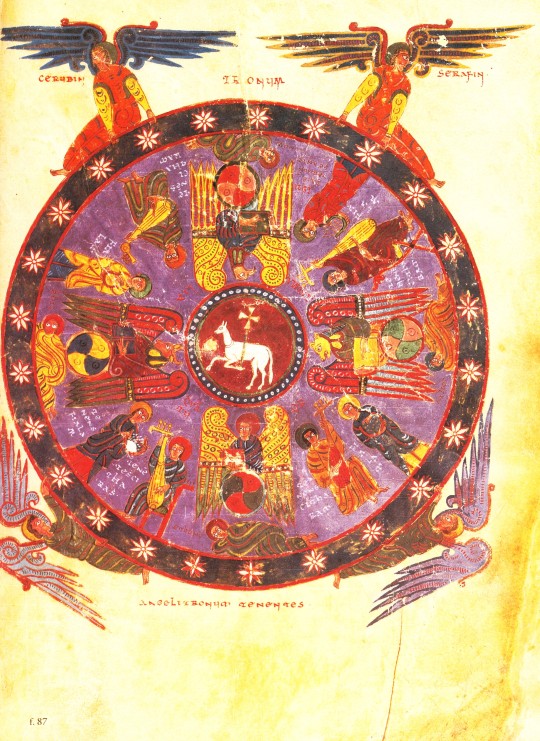

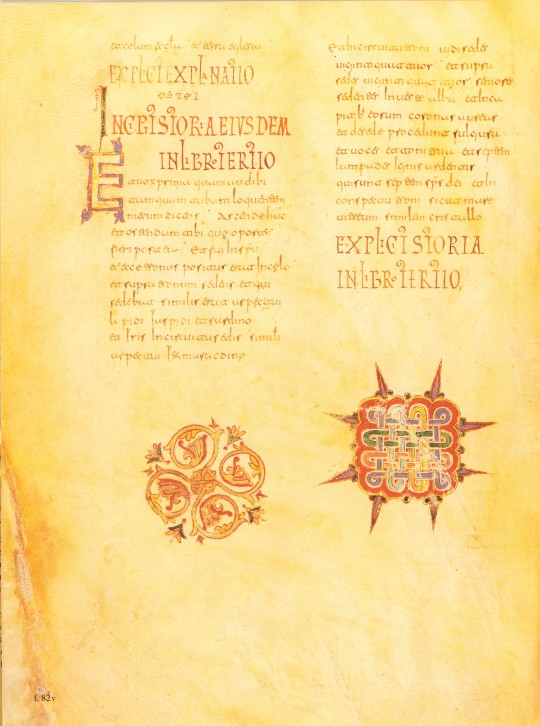
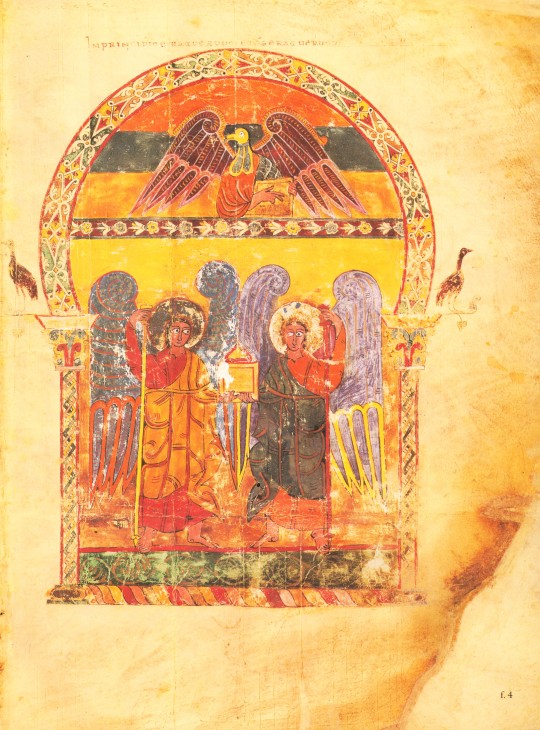




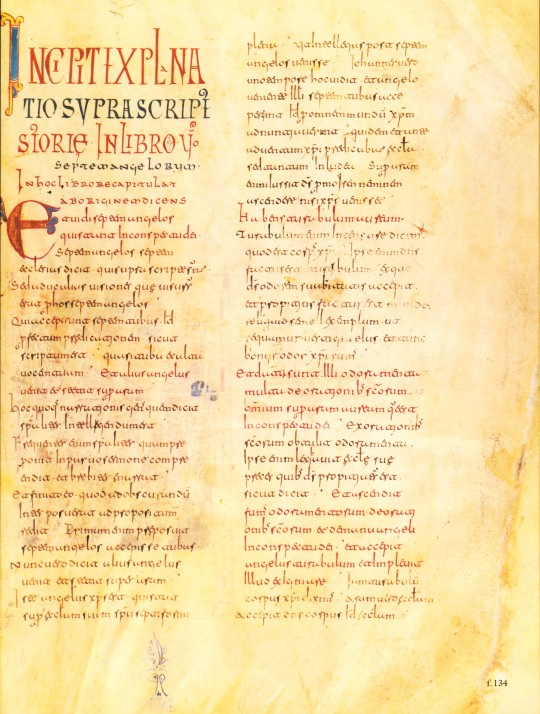
Welcome to Manuscript Monday!
In this series we will periodically focus on selections from our manuscript facsimile collection. Today we present selections from the Morgan Beatus Manuscript, reproduced as A Spanish Apocalypse, The Morgan Beatus Manuscript in New York by George Braziller, Inc. in association with the Pierpont Morgan Library in 1991. The original manuscript, made around 10th century CE at the scriptorium of San Miguel de Escalada in Spain by a monk named Maius, is the earliest surviving illuminated version of the monk Beatus of Liébana's commentary on the biblical Book of Apocalypse (also known as the Book of Revelation). The text of the Book of Revelation makes up the first part of the manuscript, and Beatus’s commentary comprises the second part. The Book of Revelation tells of the end-times in Christianity, during the final judgement of humanity by God. The story within this Biblical book was also seen by those living during the Latin medieval era as representative of the beginning of something new: God’s celestial kingdom. Due to this view of the book, many artists incorporated imagery from this part of the Bible in their work.
Produced in Al-Andalus, or Muslim-ruled Spain, the artistic style of this work combines both Muslim and Christian visual traditions to create a beautifully illuminated manuscript that supplements the commentary by the monk. This artistic style is known as the Mozarabic, which comes from the Arabic mustaʿrib, meaning ‘Arabicized’. Interestingly, this style of art can only be seen in Christian religious art and architecture from Spain at the time, as non-religious artistic objects made by Christians look so similar to Islamic versions of the same works that they cannot be identified as intentionally Christian. Some key Islamic artistic elements within the manuscript include buildings with horseshoe arches, intricate geometric and vegetal patterns as borders for larger images, and the large, bulging eyes of the illustrated animals.
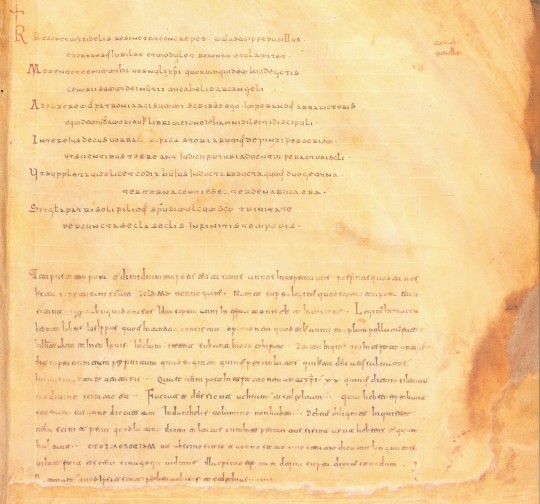
Another interesting aspect of this specific manuscript is the colophon at the end of the manuscript. It tells readers about the circumstances surrounding the creation of this book, including the maker, the patron, the year it was made, and an explanation about why Maius created the manuscript ("I write this . . . at the command of Abbot Victor, out of love for the book of the vision of John the beloved disciple. As part of its adornment I have painted a series of pictures . . . so that the wise may fear the coming of the future judgement of the world's end."). Colophons in medieval manuscripts are not usually as detailed, so the inclusion of all this information contributes greatly to the knowledge and history surrounding the Morgan Beatus Manuscript.
View more Manuscript Monday posts.
– Sarah S., Special Collections Graduate Intern
#manuscript monday#manuscripts#morgan library#morgan beatus manuscript#Beatus of Liébana#Spain#Christian art#Mozarabic#Islamic art style#facsimilies#Spanish art#Medieval art#Spanish medieval art#A Spanish Apocalypse#George Braziller#illuminated manuscripts#Sarah S.
134 notes
·
View notes
Text
The Destruction of Engine Culture:
Ok, so this is going to be another long, and rambling post. So be warned. And as usual, this is a RWS theory post, so there will be talk of scrap.
That said, let's dive into the destruction of engine culture.
So, I think the first thing to ask is what would be 'engine culture' and how would it affect the railways of Britian (and globally) - and the answer is quite simple: it's the same as human culture. Humans have developed cultures for millennia, and they are often quite similar, and this is hypothesized to be because these cultures had similar things to warn about. Warning about the dangers of flooding, of wild animals, of droughts and fires. Many of the oldest stories are tales told to teach practical lessons. Little Red Riding Hood is as much about stranger danger and the threat wild animals pose as it is a story about a crossdressing wolf. Some scientists believe games like tag and catch were developed by our hunter-gatherer ancestors to teach hand-eye coordination and improve stamina. This is of course very early culture: stories, games and songs passed down from one generation to the next - but that's what we're talking about here. Railways are 220 years old at the oldest possible (and there are surviving engines from this era), so it's an early era of culture for them.
Furthermore, engines would inherit much of their railways' culture, depending on where they are. An engine working in Tsarist Russia would grow up with that culture, whereas an engine in Argentina, or France, or Kenya would grow up with the local cultures. This includes language, music, belief systems and otherwise. So that's the basis of engine culture itself: human culture. Engines learn human language, they sing human songs and they might even take on human beliefs.


They do, however, have their own beliefs. Lady, for one, with her gold dust and magic, has been used by fanfic authors as an 'engine deity', while Thomas and Friends alluded to Proteus being a deity of some sort, with a magic lamp. These engine 'deities' exist, it seems, as a focal point for engines. Proteus represents the ability to make wishes - something engines really don't have, while Lady represents freedom. She's able to travel great distances on her own, between continents, without needing to pull trains. Does that not sound like the railway version of attaining freedom?
So the engines have 'deities'. I won't call them gods, because that's very likely not what they are, but they are legends told by older engines to younger ones.
The other kind of legends that would really dominate engine culture would be practical moral tales - in the same vein as Little Red Riding Hood being about stranger danger and the threat of wild animals, stories told between engines would be warnings about the trucks, or bad stretches of line, or dangerous weather. But unlike fairy tales, these stories would come from experience. Engine culture is very new, and it's being developed continuously during the Victorian era. Incidents like the Tay Bridge Disaster, or William Huskisson's death, or the Abbots Ripton rail disaster all are quickly turned into stories told by the older engines to teach the new arrivals (of which there are hundreds by the year) about how to run the railway as safely as possible.


The engines also develop games which help them to watch signals, or counter miles, or figure out their location in adverse conditions. These games started as training exercises, but became more fun as young engines made them competitions. They also develop songs of their own, which can tell messages:
"Once an engine when fixed to a train
Was alarmed at a few drops of rain,
So went "puff" from its funnel
Then fled to a tunnel,
And would not come out again."
The message: don't stop in a tunnel.
But the thing is, this post is about the destruction of engine culture, and now that I've explained it, I'm going to explore how it was decimated.
And for that, we start with the Second World War, which saw a complete upheaval of the railways of Britain. The war was especially hard on the railways, and engines were often used around the clock with no rest. This meant that a lot of the newer engines never got to hear these stories before being sent out for weeks at a time, as they never spent any time at a single shed. And even if they were parked up at a shed, everyone was so exhausted they didn't have time to tell tales. And at the end of the war, a lot of the oldest engines were withdrawn, completely worn out. The oldest engines were the ones who told many of the tales, and their loss was the start of a decline.


The Railway Series, however, would pick up a lot of the slack from this loss, as many of its earliest stories were in that same moral vein as traditional 'engine culture' stories, focusing on listening to elders, not stopping in tunnels, being patient, gentle with coaches, careful with trucks - it's all there. And I can see that being due to Edward teaching the Reverend many of these stories, in a bid to keep them from vanishing. And he would continue on, joined by other older engines like Skarloey, Rheneas and Toby, as the book series went on. Things like listening to advice and not acting recklessly pop up constantly - especially with Duncan, who Skarloey had to deal with.
It all gets worse when British Railways forms though. And this is where the 'railway rulebook', the attitudes of diesels and the doctrine of BR all come in to play. As the doctrine and official rulebook of British Railways portrays steam engines as inferior, weaker engines, the diesels are indoctrinated into believing it - and thus, they refuse to listen. Take Diesel for example, who believes that diesels can just arrive at a yard and 'improve it'. He is immediately foiled by some jammed breaks - something he may have learnt about from a story or a tale from a steam engine. But he never stopped to listen. And it's the same across the country, across the world in fact. As the successful diesel classes prove themselves to their managers, they are rolled out and steam engines are withdrawn - and with that, so is the culture they were the keepers of.

But this isn't quite the end of this 'engine culture' yet, because one group willing to listen to the steam engines are the 'failures'. Engines like BoCo and Derek would be very willing to listen to the engines that have tales that may just help them. Stories like how to best use sand in a storm, or how to conserve energy over the Settle-Carlisle route. And so even as steam dies, these 'failures' hold their culture, and try their best to preserve it, alongside the preserved engines. The Railway Series does too, such as in 'Stepney the Bluebell Engine', where sanding is explicitly mentioned. Another group that take in this engine culture is the GWR diesel-hydraulics, who grew up with GWR ideology, and thus would have been more willing to listen to their steam ancestors.

But these 'non-standard' engines were also quickly wiped out. And this leaves only a few pockets of engines who remember the old stories: the preserved engines, and the few Gen-1 diesels who did listen. By the end of the working lives of the Class 40s, the Deltics and the 'Peaks', they are the last engines who remember the old stories from the steam era working on British Railways, and when they are scrapped, the next generation grows up relearning everything.
Because the fact is that these stories held a major purpose, and the destruction of that culture means that every mistake every warned against is suddenly being made again, and again, and again. We notice this in the Railway Series, where Diesel, and Class 40, and D199 and even Bear all make very elementary mistakes that would have been warned against in these cultural stories - like taking care around trucks or looking out for the wind. And it only gets worse as this first generation are scrapped. Engines scramble to a standstill on leaves again, engines get trapped in floods, or lost in storms, or run through signals - and it's because the games, the songs, the stories, everything that would have prevented these accidents is lost.


It's not until these diesels reach preservation that they hear the stories remembered by the steam engines, and that's when they realise that... hey, maybe the ancestors were right after all.
The saddest part is that it's not only a global thing, but that it's still very much a problem on modern railways. The loss of 'engine culture' between the 1950s and the 1980s would have a domino effect that would still impact modern railways, as the even newer electric engines and multiple units face the same issues but with no prior knowledge.
The pictures in this post are not mine.
#fanfiction writer#thomas the tank engine#weirdowithaquill#railways#railway series#the railway series#ao3 stuff#very long post#long reads#british rail#british railways#engine culture#ttte lady#ttte proteus#ttte diesel#ttte class 40#ttte stepney#ttte analysis
112 notes
·
View notes
Text
☏ Masterlist ☏
Sonic the Hedgehog
SH Tails/Reader • SH Tails/bold yet shy!Reader • SH Tails/sleepy!Reader • SH Tails/psychopathic!Reader • SH Tails/hyper cuddly!Reader • SH Tails/adoring!Reader • SH Tails/fox!Reader • yandere SH Tails/yandere Reader • yandere SH Tails/sweetheart!Reader • Nine/unintelligent yet emotionally clever!Reader • yandere Nine/Reader • yandere Nine/human!Reader • yandere Nine/Reader Rivalry • yandere Nine/abducted!Reader • yandere Nine/sweet!seedrian!Reader • yandere Sails/Reader • Sails/traveler!Reader • yandere Mangey/Reader • Mangey/traveler!Reader • yandere WWMH Miles/Reader • yandere Kitsunami/Reader • Zor the Zeti/pregnant!Reader •
NSFW Headcanons --- Zails/female!Reader [eating you out] • Nine/female+GN!Reader [eating you out+make out sessions] •
A Once Innocent Act of Tenderness - yandere SH Tails/Reader [Community Label: Mature] • Representative of Power - SH Tails/Reader [!Smut!]
Achievement Through Appetite - Miles[Operation Crimson]/female!Reader [!Suggestive!]
It’s called Desperation, Dummy~ - Tails/Reader [!Suggestive!]
A Betrayal out of Nowhere - Zails/Reader [!Smut!]
Creepypasta
yandere Julius the Dressmaker/Reader • Julius the Dressmaker/Reader Affection •
Survival instinct didn’t make the cut - yandere Ticci Toby/Reader
Toilet-Bound Hanako-Kun
Hanako/Kou/Yashiro/Sakura/Reader who has a panic attack
Vocaloid
yandere Fukase/Reader • Fukase/Reader who lives under a rock
•#1 A State of Seduction - Fukase/Reader [!Smut!] #2 The Brattiest go Below - Fukase/Reader [!Smut!] • A Fall to Temptation - Fukase/Reader [!Smut!] •
Friday Night Funkin’
yandere Faker Sky/Reader • Faker Sky/Reader who likes to smooch her in her ‘mask off’ form • Miko/Tiktok addict!Reader
South Park // Hellpark
Hellpark Pip/sweetheart!childhood friend!Reader
So Wrong yet So Right - Hellpark Pip/Reader [!Suggestive!]
Happy Tree Friends
Flippy/sweetheart!Reader/Fliqpy
Fight Forwards Favour - Fliqpy/Reader
My Little Pony
yandere Changelings/human!Reader
Chikn nuggit
yandere Hawt Saus/Reader • yandere Fwench Fwy/biological child!Reader/yandere Iscream •
Popee the Performer
Popee/Reader
NSFW Headcanons --- yandere Popee/Reader who hate-flirts with him • yandere Eepop/Reader [stepping on him] •
Monster Hunter Stories
Dr.Manelger/assistant!Reader/Itsy-Bits
Hyoro reacts to fatally injuring his Darling
Lego Monkie Kid
Redson/male!Reader •
Disney
The Claim of an Operational Sin • Claude Frollo/female!Reader [!Suggestive!]
Misc.
yandere The Angel/Reader • Rio Ranger/Reader fluff alphabet 1/4 • Rio Ranger/Reader fluff alphabet 2/4 • Rio Ranger/Reader fluff alphabet 3/4 • Rio Ranger/Reader fluff alphabet 4/4 • Aoi/Reader/Miyuki • yandere Lucian Abbot/Reader •
Good Boy? More like... Gutter Boy • yandere Lucian Abbot/Reader [!Smut!]
Psych Ward of Partiality • Arc/Reader [!Suggestive!]
Heads or Tails for Granted • Rio Ranger/Reader [!Smut!]
Lost Chances Face Consequences • yandere Kennith Simmons/female!Reader
61 notes
·
View notes
Photo



600-Year-Old English Gold Coin Found in Newfoundland
The discovery of a rare gold coin on the south coast of Newfoundland, Canada, may challenge traditional historical narratives about the timing of European contact in the region, as it predates explorer John Cabot's arrival on the island by at least 70 years.
In a press release last week, the Government of Newfoundland and Labrador said that the English coin was found during the summer of 2022 by Edward Hynes, a local amateur historian, who reported it to officials as required under the province's Historic Resources Act. The 600-year-old coin predates the first documented European contact with North America since the Vikings, in a region with a 9,000-year-old history of human settlement and rich Indigenous traditions.
After consultation with Paul Berry, a former curator of the Bank of Canada's Currency Museum, the coin was identified as a Henry VI quarter noble, minted in London between 1422 and 1427. In the 1400s, the coin would have represented a significant sum of money, valued at 1 shilling 8 pence, or around 81 Canadian dollars ($61) today.
Prior to this discovery, a coin minted in the 1490s and found in 2021 at the province's Cupids Cove Plantation Provincial Historic Site was considered the oldest English coin ever found in Canada.
As Berry says that the coin was likely out of circulation when it was lost, there is much speculation about exactly how the gold quarter noble coin made its way to Newfoundland and Labrador. The precise location of the discovery is being kept secret to discourage treasure hunters.
The discovery of the coin underscores the intriguing archaeological record in Newfoundland and Labrador, Canada's easternmost province. Stories of Viking arrival are contained in Icelandic sagas, citing visits by Leif Erikson over 1,000 years ago, and archaeological evidence of a Norse settlement, which was found in L'Anse aux Meadows, Newfoundland, and declared a Unesco World Heritage site in 1978.
Other unconfirmed accounts of European contact include tales from England's Channel Islands about a ship being blown off course in the late 15th century into a strange land full of fish; historical Portuguese maps depicting Terra do Bacalhau (or, the land of codfish); and the "Voyage of Saint Brendan," a legendary account of an early 6th-century sea voyage by an Irish abbot.
In 1583, Newfoundland became England's first possession in North America and the establishment of fishing operations on the outer coastline of the island cut off access to traditional food sources for the indigenous population.
"There's been some knowledge of a pre-16th century European presence here for a while, you know, excluding Norse and so on," Brake told CBC. "The possibility of perhaps a pre-16th century occupation would be pretty amazing and highly significant in this part of the world."
#600-Year-Old English Gold Coin Found in Newfoundland#Edward Hynes#metal detector#metal detecting finds#archeology#archeolgst#gold#gold coin#Henry VI quarter noble#treasure#ancient artifacts#history#history news#ancient history#ancient culture#ancient civilizations
196 notes
·
View notes
Text
My own for fun fleshing out of the idea posited by Jonathan Morris that the other voices Xoanon adopts in the Face of Evil are forgotten incarnations plucked from the Doctor's subconscious.
Specifically played by Pamela Salem, Rob Edwards, Anthony Frieze and Roy Herrick.
The First Xoanon Doctor (Pamela Salem)
This incarnation was posted on Earth by her request, as part of the Time Lords solidifying of the Web of Time as history, arriving in the era of the First World War. Upbeat and playful, she had a knack for outmanoeuvring her opponents even in spite of the cultural pushback against the form this incarnation took. She also often came across as anachronistic due to a lack of understanding of the culture of the era of this planet that she was assigned to. She, however, was occasionally prone to seeing humans more as interesting specimens than individuals in their own right.
The Second Xoanon Doctor (Rob Edwards)
Coming across as an eccentric but kindly Professor-like figure, wearing a scruffier version of a formal outfit. This incarnation took up teaching on Earth. He was heavily interested in the idea of luck as an external force and wore a clover on his lapel to represent that. He was prone to meddling in events outside his purview, but only subtly, within his remit as an agent of the Time Lords and thus often employed luck or what appeared to be luck as a ‘weapon’ of sorts in said situations, despite his pleasant exterior he was capable of doing almost anything if he thought it would benefit the ‘greater good’. He was the first incarnation to meet the Abbot.
The Third Xoanon Doctor (Anthony Frieze)
This incarnation lived for a long time, aging up from a child to an adult. He spent a lot of his time on Gallifrey, getting involved in the internal politics of the planet as an advocate for the Non-Intervention policy. He regretted the meddling his immediate predecessor was prone to, though he still returned to Earth to observe the planet and would occasionally intervene if he found a situation significant enough to warrant it. He was brash and abrasive, and had a superiority complex, but still was a kind-hearted person when the chips were down. He met his end in service to Gallifrey in the midst of a Time War.
The Fourth Xoanon Doctor (Roy Herrick)
A calmer, younger, mellower incarnation. This Doctor prided himself on his moral compass, whilst he still acted as an agent for the Time Lords, he treated the role as secondary to his interest in the planet Earth and its people. He was granted an official remit to travel across the Universe, rather than just the history of the planet he was observing, as a result of a great service to Gallifrey during his early life. He was also one of few early incarnations of the Doctor who contemplated any form of relationship with a human, though he ultimately never went through with it. Despite this, he still maintained a wide social network in the era to which he was assigned.
(Did an amateur artwork, also including headcanons for the 'eras' under the assumption of them directly preceding the Morbius Doctors from Forgotten Lives)
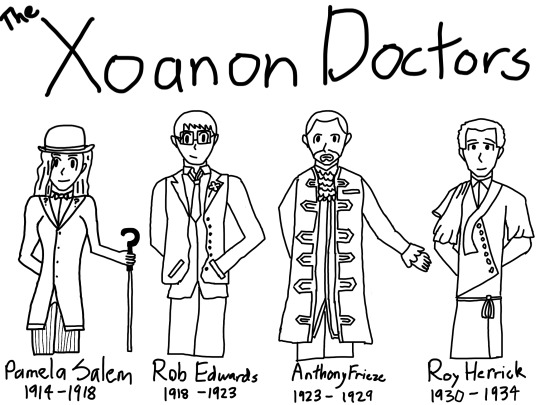
#doctor who#dweu#doctor who eu#forgottenlives#forgottenlivesobverse#morbius doctors#xoanon doctors#pamela salem#rob edwards#anthony frieze#roy herrick#obverse books
12 notes
·
View notes
Text


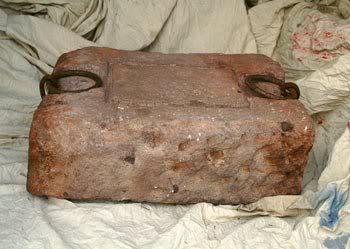
On 11th of April 1951 The Stone of Scone, the stone upon which Scottish monarchs were traditionally crowned, was found on the site of the altar of Arbroath Abbey.
It’s always good to get details from the era in posts, this is a contemporary newspaper report of the event.
Three and a half months after its removal from the Coronation Chair in Westminster Abbey early on Christmas morning, the Stone of Scone was to-day deposited in Arbroath Abbey in Scotland. Three men drove up to the abbey and carried the stone, which was draped in a St. Andrew’s flag along the main aisle before laying it at the high altar, on the grave of King William the Lion of Scotland.
The stone was handed over to Mr. James Wishart, custodian of the abbey, who remained with it until a detachment from Angus County Police took possession. Afterwards it was removed to Forfar, where it lay in a locked cell at police headquarters for the night. On top of the stone two unsigned letters were left: one addressed to the King and the other to the General Assembly of the Church of Scotland as “successor to the Abbots of Scone.”
The letter to the King read:
“Unto his Majesty King George VI, the address of his Majesty’s Scottish subjects who removed the Stone of Destiny from Westminster Abbey and have since retained it in Scotland, humbly showeth.
"That in their actions they, as loyal subjects, have intended no indignity or injury to his Majesty or to the Royal Family.
"That they have been inspired in all they have done by their deep love of his Majesty’s realm of Scotland and by their desire to compel the attention of his Majesty’s Minister to the widely expressed demand of Scottish people for a measure of self-government.
"That in removing the Stone of Destiny they were restoring to the people of Scotland the most ancient and most honourable part of the Scottish regalia, which for many centuries was venerated as the palladium of their liberty and which in 1296 was violently pillaged from Scotland in the false hope that it would be the symbol of their humiliation and conquest.
"That the stone was kept in Westminster Abbey in defiance of a royal command and despite the promise of its return to Scotland.
"That by no other means than the forceful removal of the stone from Westminster Abbey was it possible even to secure discussion as to its rightful resting place.
"That it is the earnest hope of his Majesty’s Scottish people that arrangements for the proper disposition of the stone may now be made after consultation with the General Assembly of the Church of Scotland who as successors of the Abbots of Scone are its natural guardians.
"That it is the earnest prayer of his Majesty’s loyal subjects who have served his Majesty both in peace and war that the blessing of Almighty God be with the King and all his peoples so that in peace they may enjoy the freedom which sustains the loyalty of affection rather than the obedience of servility. God save the King.”
The letter which was addressed to the General Assembly of the Church of Scotland asked that the representatives of the Church should “speak for the whole people and arrange with the public authorities in England that the Stone of Destiny will be retained in Scotland.”
wo Arbroath town councillors, Mr. D.A. Gardner and Mr. F.W.A. Thornton, both of whom are prominently associated with the Scottish Convention movement, were waiting at the entrance to the abbey when the three men arrived. Mr. Thornton helped them to carry the stone in, and Mr. Gardner went to Arbroath police station to inform the police that the stone was lying in the abbey.
Mr. Wishart, who is 63 and has been custodian at the abbey for nine years, told a reporter that the men got out of the car and started to take a heavy object from the back seat. Councillor Gardner came up and said: “Is that the Stone of Destiny you have?”
Mr. Wishart said that Mr. Thornton and three men carried the stone on a wooden litter up what used to be the nave of the abbey between the ruins of the pillars. “They laid it at the three stones which marked the site of the high altar. They carried the stone in a reverent manner, their heads were uncovered, and it was a solemn and impressive little ceremony. The men shook hands with me and wished me the best of luck and then went. As soon as I knew that the Stone of Destiny had been placed in my charge I locked the gates.”
Mr. Wishart said that the three men were “young well set-up lads,” but apart from that he was unable to give a description of them. The car was big and dark-coloured, but he did not note the registration number. “I have always told visitors that one day the Stone of Destiny would come to this historic spot,” he said, “and I am glad that my words have come true.”
On 13 April the Stone was returned to Westminster Abbey.
A wee bit history behind the stone, the first Scottish monarch to be crowned atop the stone in the 11th century, with John Balliol the last King to use the stone on Scottish soil in 1292.
In 1296, the stone was captured by Edward I as spoils of war and taken to Westminster Abbey. On St Andrews Day 1996, the Stone of Destiny was legally returned to Scotland with a ceremony and celebration befitting its status. Since that day, it has remained within the confines of Edinburgh Castle alongside the Honours of Scotland. Thousands lined the Royal Mile to see the stone escorted from the Palace of Holyrood House to the castle.
66 notes
·
View notes
Note
Do all/most of JTTW’s monsters of the week represent specific obstacles during the journey to enlightenment? Like, I heard the the Six Eared Macaque represents a dark side to/illusionary/second mind, but what about some of the other villains?
I can't say for sure if there are other allegories that are quite as clear cut as the facing-your-own-doppelganger/evil self trope but I do like to think that each demon/trail has its own lesson in its own ways.
There are A LOT of demons (or antagonists in general) in JTTW, I tried to make a list about each one and how they were subdued (it's not complete and I'm afraid I've been lazy) to try to see how each demon fit into the story. Of course, I'm sure that each demon could have an allegory within their battles, as there is demons that have underlying meanings.
Bull Demon King - Wukong fighting someone he has a past with, being forced to face that past and having to cut ties with his family
Yellow Robe Demon - The demon that became a demon for the sake of following his love, perhaps paralleling how Wukong came back due to his own loyalty to his pilgrimage.
The Old Abbot - suppose to be a symbol for other monks to follow but instead gave in to his own greed, paralleling Tang Sanzang's own humbleness.
These are all my personal takes, there isn't really any discussion about them and these are like only the first few demons. I'm not saying that each demon DOES have a lesson and maybe I will do a more in-depth look once I have time and re-read JTTW.
But until then maybe it is best to say it's left to interpretation and see what you think for yourself!
This is an attempt me making an easy to read/access JTTW demon list.
But I'll have to keep in mind what the other might represent symbolically throughout the journey! Thanks for asking that!
84 notes
·
View notes
Text

The Harrowing of Hell from the Winchester Psalter (Winchester, Priory of St Swithun, c 1150 CE): An angel locking the door of Hell. Hell is represented as a great mouth within which are human beings and devils.
British Library, London, MS Nero C IV, f. 39r
The book also includes a Calendar, which provides evidence as to its origin. Saints of particular relevance to Winchester are included, among them Bishops Æthelwold (d. 984) and Brinstan (d. 934), and saints buried or with shrines there, such as Eadburh (d. c. 951), a Benedictine nun and daughter of Edward the Elder, and Grimbald (d. 901?), by tradition the co-founder of New Minster (later Hyde Abbey). The Calendar also includes two abbots of Cluny in Burgundy, Sts Hugh (d. 1109) and Mailous (d. 994).
The bishop of Winchester throughout the middle of the 12th century was King Stephen’s younger brother, Henry of Blois (r. 1139–71), who had been educated at Cluny. Henry was one of the richest men in Europe and a known art and relic collector. When appointed to the see of Winchester, he refused to relinquish the profitable abbacy of Glastonbury, which he held concurrently with Winchester until his death. The Cluniac references, Cathedral-specific prayer and Henry’s great wealth make him a plausible patron for such a lavish book, even if its vernacular components and central focus on the Psalms in French suggests that he may have intended it as a gift for a layperson.
[Robert Scott Horton]
* * * *
“The gates of hell are open night and day;
Smooth the descent, and easy is the way:
But to return, and view the cheerful skies,
In this the task and mighty labor lies.”
― Virgil, The Aeneid
+
“They say that in the second before our death, each of us understands the real reason for our existence, and out of that moment, heaven or hell is born.”
― Paulo Coelho, Aleph
15 notes
·
View notes
Note
Sometimes I feel like we are all reliving the 1930s, hurtling uncontrollably toward the 1940s and to WWIII. I don't think I'm overreacting when I see what's happening in the US and Italy, to say nothing of Russian aggression in Ukraine. As a historian, can you give me any hope, any examples where events of that era could have taken a different turn and where current times could turn out differently? Sorry to dump my angst on you.
Welp. I've been thinking about this ask for a bit, and I'll try to see if I can say anything that makes sense and is both realistic and hopeful. So here goes.
First off, history is not "fixed." It's easy to look back and say "oh, it could only have ever gone that way," but that's not true. So yes, there are literally countless examples, even in the 1920s/30s period between the world wars, and in the wars themselves, where things could have gone differently. People could have made different choices or acted in different ways, things could have broken different ways, luck could have been bad instead of good, good instead of bad -- etc etc. It's just life, and it happened the way life does: messily, chaotically, accidentally, unpredictably, until it was over and eventually people started looking back at it and studying it to see what that was. But it wasn't predetermined to happen that way, and nothing is predetermined or utterly destined to happen now. Yes, there are a lot of unsettling historical parallels -- war, plague, economic unrest, social inequality, etc etc -- that really makes you wonder if all of human history is just repeating our same mistakes in 100-year cycles. I struggle with this feeling myself, especially since as a historian, I DO know so much about what has gone on and failed to work before, and it astonishes me, not in a good way, that it's still happening now.
That said: people are so used to thinking of the study of history as Finding Out What Happened In the Past, and believing that there is only one singular narrative of what "did" happen, which can be uncovered and confirmed by objective theory and universally agreed truth. This was a historiographic theory popularized by Leopold von Ranke, a 19th-century German historian, who was trying to make the writing of history more scientific and systematic and following the essential rules of natural sciences (as the Germans were doing with a lot of academic disciplines in the 19th century). This had its merits in making the practice of history more rigorous and well-researched, but it also completely discounts the fact that all of human experience, experienced by all humans everywhere, cannot POSSIBLY be objective, or agreed on a single perspective, or represented everywhere. History happened to everyone everywhere, in all times and places, even if it wasn't the things that a certain person felt like writing down for posterity. One of my favorite anecdotes is that of a monk keeping a regional chronicle of events -- I can't remember where, in France or possibly Germany in the early 11th century or thereabouts. Next to a famous date, where an emperor died or a pope was overthrown or something of the sort (apologies again that it's early and I can't remember that either), he wrote essentially, "Nothing much happened this year. My brother who was abbot died."
Anyway, that really just sums it up for me. This monk was living in the middle of major events that would interest later historians, but he didn't know that or see that at the time, and his interest in chronicling this year was to write that his brother, who was an abbot, died. He was experiencing history by living his life and commenting on the places he lived and the people who he knew. That is because history is the monk's brother dying, as much as the emperor being overthrown; it happened in these small personal moments, as well as these huge political things. We see things and patterns in hindsight that look much clearer and put together than they actually were, but it's just the collective sum of human experience, good and bad alike.
As I have always said, people are people, in all times and places, and that means there's always hope, and there's always love, and it's usually right. Let me leave you with an absolutely heart-shredding passage from John Clyn, a fourteenth-century Irish monk and chronicler who was writing in 1349, just as the Black Death was sweeping over his monastery and leaving him as the only survivor. Alone and probably already ill with plague himself, Clyn wrote:
"So that notable deeds should not perish with time, and be lost from the memory of future generations, I, seeing these many ills, and that the whole world encompassed by evil, waiting among the dead for death to come, have committed to writing what I have truly heard and examined; and so that the writing does not perish with the writer, or the work fail with the workman, I leave parchment for continuing the work, in case anyone should still be alive in the future and any son of Adam can escape this pestilence and continue the work thus begun."
And just. My God. Even as he is "waiting among the dead for death to come," Clyn the historian finishes his work. He has committed to writing down what happened for future generations, because he still believed that there would be one. He saw the whole world "encompassed by evil," but he left parchment for someone else to write more, because if anyone should be alive in the future and anyone escaped the plague, they would want to continue the work. Of living, and writing, and doing history, and trying again. And you know what? He was right. Sons of Adam (and daughters of Eve, and children of God) did escape the pestilence. Not everybody died. Society was changed and rebuilt and life went on. The work did not fail with the workman. The future came. And the future will come again, even in the darkest and most terrible of hours.
Hugs.
168 notes
·
View notes
Text

Request a drabble using this prompt list!
"I swear, it's like he has eyes everywhere. I can't even buy a lump of cheese and a loaf of bread without him breathing down my neck."
Mumbles Piper, taking a swig out of his mug of Moomoo Milk before slamming it on the counter.
"Every piece of gold, every purchase we make-"
"All is accounted for, he's quite good at what he does. He's always been like that, even back at Mistralton."
Antoniou muses, swirling a mixing stick into his cup of coffee. Compared to the rest of the party, concerned at best, annoyed at worst, he was glowing with pride.
"It is quite impressive, actually. A true student of the Mistralton branch."
"Impressive?! It's creepy!"
Kurusu glances from the other end of the counter, fist clenching into a cup of hot cocoa.
"I make one purchase at some small store downtown and he's on my case all night about it! How is a chocolate bar going to 'financially murder the entire party', and how is it my fault entirely?!"
"A chocolate bar is nothing,"
Abbot laughs- he's the man behind the counter, the one preparing the party's drinks.
"I was in a rush to buy herbs and medicines- you know, so I could do my job as an apothecary; next thing I know, I've built up quite a tab in the store. No problem, I think, I'll pay it all of- but since Ohashi hasn't heard of these purchases, and I've amassed quite a debt, well,"
He pours a questionable liquid into a mug, a murky, sparkling gray.
"I learned my lesson- though I'm not allowed to experiment any new formulas for the time being, on account of Ohashi banning me from using the party's funds."
"Serves you Right,"
Abbot glares, but doesn't argue.
Lobanov takes the curious concoction, swirling it in his hands.
"He's a Little Debt Collector, That one. Very Terrifying- but What do you Expect, he is a Merchant of Plasma Harmonia Academia."
"I think he's doing a really good job then,"
Grumbles Descante- his own choice of drink was a simple, freshly squeezed lemonade; and he hoped Abbot didn't add anything to it.
"Representing the academy's business majors, I mean. Don't we have to pay him three pieces of gold daily?"
"The staff at Aspertia would put down donation boxes,"
Slater whispers under his breath, lips pressed against the rim of his teacup- his choice of drink was Pecha tea with coconut milk.
"It wouldn't be so bad if it wasn't, um, mandatory."
"Little bloodsucking parasites,"
Technamare puts up his smoothie for Aibert to drink from- clearly annoyed at the mention of collecting fees.
"Opelucid wasn't any better- an entrance fee for the exams, the tuition, they didn't even offer scholarships, when they're the branch that'd benefit from having one!"
"Nice to know that, aside from running cults, planning deaths, masterminding this whole ordeal while carrying out this so-called god's will-"
Abbot slides Kurosawa his drink- a cup of Iapapa berry juice.
"-they're also stealing money from us."
Piper rolls his eyes. "And you guys say I'm the traitor-"
Technamare immediately looks at the thief. "You literally are-"
Piper waves his hand dismissively. "Yeah, fine, it was a one time thing-"
Descante, furrowed eyebrows, speaks up next. "You tried to kill Slater-"
"Well, I stopped doing that! Unlike Ohashi who bleeds us dry every time!"
"Who's bleeding who dry?"
The rest of the party goes quiet.
Stepping inside Abbot's private bar, Ohashi steps in with the sound of his wares jingling inside his backpack- as a merchant, he carried business as usual even as the party were labeled fugitives and heretics by the rest of the world, and maintained steady connections.
Out of all of them, it was no doubt Ohashi worked the hardest.
Yet.
Everyone turns away- completely unwilling to fess up.
Ohashi needs no confirmation, however.
"I take it the ingredients used for everyone's drinks were part of yesterday's trip to the market, Abbaticcio?"
"Right," There's a peaceful smile as he wipes a glass- it's hard to tell if it was fake or not. "No need to worry about that."
"Hmph. You say that,"
He glances at everyone.
He must have some sort of innate magic ability, Piper thought, because his glare was the iciest it's ever been- and the way it quickly melts into something, one of seething rage-
"-but while you lot were here gossiping amongst yourselves, I've observed there's been discrepancies between the reported expenses and our current budget."
Uh-oh.
"Kurosawa, Piper, Kurusu, Lobanov-"
The rest unmentioned quickly rose to their feet, scampering upstairs. Abbot hastily throws the last of the cleaned glasses into the shelf and makes a run for it.
"-meet me outside. We need to talk."
Kurusu looks like he wants to argue- but shrinks back when Ohashi stares into his exposed eye.
With a shrug, Lobanov takes one last sip of Abbot's strange drink, stretching his muscles and walking outside with Kurusu clinging to his coat.
"What did you buy?" Kurosawa asked. "You're the one always in trouble with him."
"You're in his bad books too!"
"It was probably some bandages I brought in a rush!"
"Like hell it was!"
"Both of you,"
Placing gloved hands on their shoulders, Ohashi leans close.
"Like it or not, I'll never part from your side,"
It was less of a reassurance- especially with how tightly he squeezed.
"So while I'm around, you better pay your dues. Otherwise,"
Somehow, out of everything we've encountered so far-
"You'll know why they warn you about making a deal with the devil."
-why is Ohashi the scariest?!
9 notes
·
View notes
Text
1st March
St David’s Day
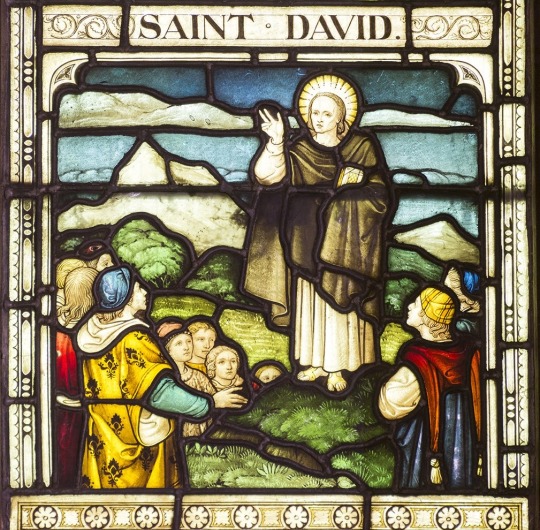
Source: Welsh Saints from Welsh Churches by Martin Crampin/ Mae Ffydd Yn Cyrif website
Today is St David’s Day. The patron saint of Wales, David died on 1st March 589. He was founder and Abbot of Glyn Rhosyn monastery in Dyfed (now the town of St Davids). The construction of David’s monastic seat was not trouble free and his builders were assailed by a local pagan known as Boia who wanted to prevent the work going ahead. David, who was a great preacher and proselytiser, spoke to Boia and converted him to Christianity on the spot. Although Boia’s wife then sent her handmaidens naked to distract David’s labourers, such was the saint’s oratorical power, not a man wavered and the monastery was completed.
David’s fame spread when he began miraculously to make wells appear, but his patron sainthood really owes itself to his spirit appearing to King Cadwallon of Gwynedd on the eve of the Battle of Hatfield Moors in South Yorkshire against King Edwin of Northumbria. He advised the Britons to place leeks in their helmets, the better to distinguish themselves from their English foes in the heat of battle. This they did and triumphed on the field. Although this visitation confirmed David as the patron saint of Wales and the leek as its national vegetable, Cadwallon himself did not consider himself Welsh (an English term for “foreigner”): as far as he was concerned, he was leading a Celtic attempt to evict the invading Angles from northern Britain, and he nearly succeeded. Nonetheless, from the British victory at Hatfield, it became traditional for the Welsh to wear leeks on St David’s Day, although these days a discreet daffodil lapel pin is more likely to be seen.
In Lanark, an obscure, but possibly quite ancient, mock battle takes place at the local church, named Whuppity Stourie. Two sets of lads, representing New and Old Lanark, run three times sunwise round the church before engaging in combat, traditionally using their caps as weapons, at Wellgate Head. The fight now takes place with paper maces, after the two gangs had dangerously substituted their caps for stones. With its running around a sacred building followed by a pummelling contest, Whuppity Stourie may have a winter vs spring ritual origin, with the forces of winter darkness being beaten back, but ultimately it may merely have been a way of controlling youthful gang violence in the town.
#st david#wales#leek#glyn rhosyn#st davids Dyfed#battle of Hatfield Moors#king Cadwallon#king Edwin of Northumbria#lanark#Whuppity Stourie
5 notes
·
View notes
Text
#OTD in Irish History | 3 September:
In the Liturgical calendar, it is the Feast day of St McNisse, baptised by St Patrick, and later consecrated him the first abbot-bishop of Kells, which became the diocese of Connor.
1649 – The Siege of Drogheda begins.
1654 – The first Protectorate parliament meets; Ireland is represented by 30 members.
1658 – Nine years after the Siege of Drogheda starts, Oliver Cromwell dies. He is probably the…

View On WordPress
#irelandinspires#irishhistory#OTD#3 September#History#History of Ireland#Ireland#Irish History#John Devoy#Liam Maguire#Oliver Cromwell#Omagh Bombing#Pope John Paul II#Today in Irish History
14 notes
·
View notes
Text

Saint Bernard preaching the Second Crusade before King Louis VII, his queen Eleanor of Aquitaine, and Abbot Suger, at Vézelay in Burgundy, 31 March, 1146
by Émile Signol
James Meeker Ludlow describes the scene romantically in his book The Age of the Crusades:
A large platform was erected on a hill outside the city. King and monk stood together, representing the combined will of earth and heaven. The enthusiasm of the assembly of Clermont in 1095, when Peter the Hermit and Urban II launched the first crusade, was matched by the holy fervor inspired by Bernard as he cried, "O ye who listen to me! Hasten to appease the anger of heaven, but no longer implore its goodness by vain complaints. Clothe yourselves in sackcloth, but also cover yourselves with your impenetrable bucklers. The din of arms, the danger, the labors, the fatigues of war, are the penances that God now imposes upon you. Hasten then to expiate your sins by victories over the Infidels, and let the deliverance of the holy places be the reward of your repentance." As in the olden scene, the cry "Deus vult! Deus vult! " rolled over the fields, and was echoed by the voice of the orator: "Cursed be he who does not stain his sword with blood."
#second crusade#medieval#bernard of clairvaux#st bernard#saint bernard#knights#vézelay#burgundy#france#french#art#émile signol#history#christianity#christian#europe#european#middle ages#knights templars#crusades#crusaders#crusade#king of france#eleanor of aquitaine#king louis vii
59 notes
·
View notes